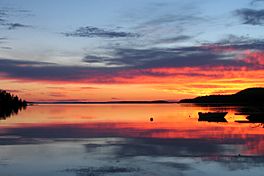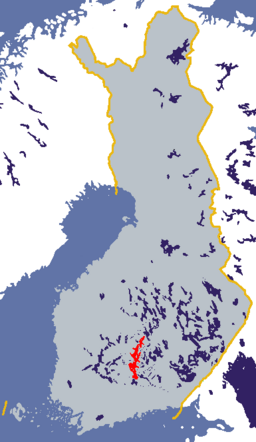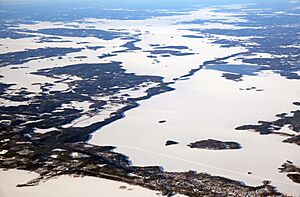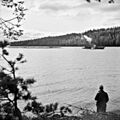Lake Päijänne facts for kids
Quick facts for kids Päijänne |
|
|---|---|

Päijänne and Päijätsalo
|
|
 |
|
| Coordinates | 61°35′N 025°30′E / 61.583°N 25.500°E |
| Primary outflows | Kymi River |
| Basin countries | Finland |
| Max. length | 120 km (75 mi) |
| Surface area | 1,070–1,082.89 km2 (413.13–418.11 sq mi) |
| Average depth | 16.2–18 m (53–59 ft) |
| Max. depth | 95.3 m (313 ft) |
| Water volume | 18.1 km3 (4.3 cu mi) |
| Residence time | 2.5 years |
| Surface elevation | 78.3 m (257 ft) |
| Islands | 1886 (Virmailansaari, Salonsaari, Judinsalo, Onkisalo, Paatsalo, Muuratsalo, Haukkasalo, Vuoritsalo, Mustassalo, Edessalo, Taivassalo) |
| Settlements | Asikkala, Jyväskylä, Korpilahti, Kuhmoinen, Luhanka, Muurame, Padasjoki, Sysmä |
Lake Päijänne is the second largest lake in Finland. It covers an area of about 1,080 square kilometers. This huge lake drains its water into the Gulf of Finland through the Kymi River.
Päijänne is also home to the deepest point in any Finnish lake. It reaches an amazing depth of 95.3 meters (about 313 feet)! The largest city on its shores is Jyväskylä in the north.
One cool fact about Lake Päijänne is the Päijänne Water Tunnel. This is an underground tunnel that carries water from the lake all the way to Vantaa. It provides drinking water for the Greater Helsinki area.
The lake has many islands, with over 1,800 in total. The biggest island is Virmailansaari. In Finnish, the word saari means "island." The word salo used to mean a large island, but now it often means a big forest area. The name Päijänne itself might come from a very old language spoken before Finnish.
Contents
Exploring Lake Päijänne
Lake Päijänne is a popular spot for many water activities. People love to go boating, canoeing, and sailing here. The lake is about 119 kilometers (74 miles) long.
It is connected to other lakes like Lake Keitele and Lake Vesijärvi by canals. These connections create a long waterway for ships, stretching about 380 kilometers (236 miles)! There have been talks for a long time about building canals to connect Päijänne to the Baltic Sea, but this plan has not happened yet.
Past and Present Transportation
Before the 1940s, Lake Päijänne was a very important way to travel in Central Finland. Many ships carried people and goods between the towns and cities along the lake's shores.
Today, passenger boat trips are mostly for tourists. They are a fun way to see the lake, rather than the fastest way to get around. In the summer, one popular route is between the cities of Lahti and Jyväskylä.
Passenger Ships on Päijänne
Here are some of the passenger ships that sail on Lake Päijänne today:
| Name | Built | Passengers | Length | Width | Speed | Home harbour |
|---|---|---|---|---|---|---|
| M/S Aino | 1922 | 90 | 17,20 m | 4,10 m | 11 knots | Lahti |
| M/S Elbatar | 1984 | 90 | 16,08 m | 4,78 m | 11 knots | Padasjoki |
| M/S Jenni-Maria II | 1970 | 30 | 15,30 m | 3,80 m | 15 knots | Sysmä |
| S/S Laitiala | 1903 | 130 | 26,7 m | 6,64 m | Lahti, charter ferry | |
| M/S Suometar | 199 | Jyväskylä | ||||
| S/S Suomi | 1906 | 199 | 31,60 m | 2,13 m | Jyväskylä | |
| M/S Wellamo | 1990 | 190 | Lahti |
Tourism and Nature
Lake Päijänne is a popular place for tourists. Many people own cottages along its shores, with about 16,000 cottages in total. Most of these are private and have their own sauna buildings.
Besides cottage holidays, people visit Päijänne for many outdoor activities. These include fishing, sailing, canoeing, rowing, and trekking. In winter, you can even go ice-skating or ride a snowmobile.
The Päijänne National Park and Leivonmäki National Park are also big attractions. Tens of thousands of visitors come to these parks every year to enjoy nature. In 1995, an organization called "The Clear and Drinkable Lake Päijänne South Association" won an award from the European Union for its work in tourism and environment.
National Parks Around Päijänne
The Päijänne National Park is located in the southern part of Lake Päijänne. It includes 50 islands that have not been built on, as well as parts of some inhabited islands. This park was created in 1993 and covers an area of 14 square kilometers (5.4 square miles).
Leivonmäki National Park is another beautiful park. It is located a few kilometers northeast of the northern part of Lake Päijänne. It is one of Finland's newer national parks.
Cities and Towns on Lake Päijänne
Many cities and towns are located along the shores of Lake Päijänne. Here are some of them, listed from north to south:
- Jyväskylä
- Säynätsalo
- Muurame
- Toivakka
- Korpilahti
- Jämsä
- Luhanka
- Joutsa
- Kuhmoinen
- Sysmä
- Padasjoki
- Asikkala
Images for kids
-
Kärkinen bridge in Korpilahti, Jyväskylä during the Päijännepurjehdus sailing competition
-
Passenger steam ships S/S Jyväskylä, S/S Suomi, S/S Taru and S/S Tehi in Pihlajakoski harbour, Kuhmoinen in 1938
See also
 In Spanish: Lago Päijänne para niños
In Spanish: Lago Päijänne para niños
- Päijänne National Park













